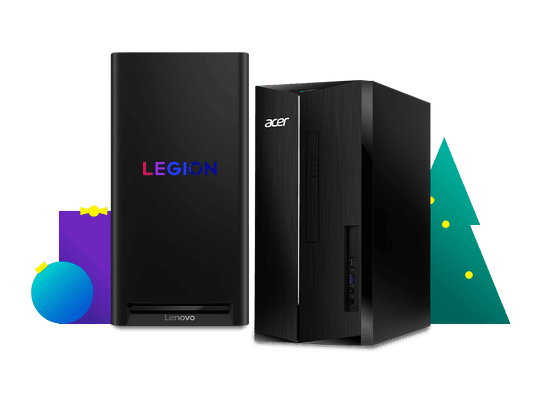Desktop Computers

Learn more about desktop computers
Our Holiday Price Guarantees
Shop deals early knowing that the price of any product with a "Boxing Day Price Now" or "Lowest Price of Dec." badge won't go any lower. If it does, we'll refund the difference. Guaranteed.
How to Buy a Desktop Computer
Whether you're searching for a desktop computer that can handle graphics-heavy games, creative projects, or everyday tasks like web browsing and streaming, Best Buy Canada offers a wide selection of Windows PCs and Apple Macs to fit your needs. We'll help you understand the key specs and features to look for, so you can find the right desktop to match your lifestyle and budget.
What Will You Use Your Desktop For?
Desktop computers come in many forms, from everyday performers built for simple tasks to powerful systems designed for gaming, video editing, and 3D design. Some models are built to handle a bit of everything, offering fast processors, strong connectivity options, and enough storage to manage work, entertainment, and multitasking with ease. If you prefer a sleek, space-saving option, all-in-one desktops like Apple’s iMac or Windows-based models combine the monitor and computer into one stylish unit, making them a great choice for home offices and creative workspaces.
Understanding RAM, Storage, and Graphics Cards
Knowing the basics of a desktop's key components can make it easier to choose the right model. The processor, or CPU, acts as the brain of the system, handling everything from simple tasks to complex programs. Modern multi-core processors from Intel, AMD, and Apple’s M-series deliver excellent speed and efficiency. RAM (random access memory) helps your computer run multiple apps smoothly; more memory means better multitasking. Storage drives come in two main types: traditional hard disk drives (HDDs) and faster solid-state drives (SSDs), which help your computer boot up and load files quickly. Graphics cards handle video and visual performance, with integrated options ideal for everyday use and dedicated cards offering the power needed for gaming, VR, and creative software.
Choosing the Right Size
Desktops come in several sizes and form factors. All-in-one computers combine a large screen with internal components, making them perfect for clean, clutter-free setups. Mini PCs and compact desktops like the Mac Mini offer great performance in a small, energy-efficient package that fits almost anywhere. Traditional tower desktops provide the most versatility, allowing you to customize and upgrade components like graphics cards, memory, and storage as your needs evolve. Whether you need a minimal footprint or room for expansion, there’s a desktop size that fits your space.
Understanding Operating Systems
Every desktop runs on an operating system (OS), which manages software, files, and system settings. The two most common options are Microsoft Windows and Apple macOS. Windows 11 powers the latest Windows desktops, offering a streamlined user experience, smarter multitasking tools, and enhanced security features. Apple’s macOS provides a clean, intuitive environment favored by creative professionals. If you prefer working online and want a simple, secure experience, some desktops also run ChromeOS, which is designed around cloud storage and quick access to web apps.
FAQs
Why Choose a Desktop Over a Laptop?
While laptops offer portability, desktops deliver more power, better upgrade options, and excellent value for performance. Many modern desktops come in sleek designs that blend into any space and can be upgraded over time with new components like RAM or storage. Even budget desktops often offer strong processing power and multiple connectivity options, making them a smart choice for work, creativity, or family use.
What Is the Best Desktop for a Student?
For students, a reliable desktop that can handle eveyday tasks like word processing, research, video streaming, and social networking is ideal. Compact all-in-ones and mini PCs are great options for dorm rooms or shared spaces, offering enough power without taking up too much room. Choosing a desktop with cloud backup capabilities can also help protect important files and assignments in case of device loss or damage.
What’s New in Desktop Computers?
Today’s desktop computers are faster, smarter, and more connected than ever. Equipped with the latest Intel Core, AMD Ryzen, and Apple M-series processors, modern desktops deliver impressive speed and energy efficiency. Windows 11 desktops are optimized for better multitasking, gaming, and creative workflows, while macOS devices continue to offer strong integration with creative apps and services. High-speed connectivity like Wi-Fi 6 and USB-C is becoming standard, while strong security features, including real-time encryption and advanced protection at the OS level, keep your data safer. Faster SSDs are now common, dramatically improving startup times and file access, and modern graphics cards bring stunning visuals for gaming, 4K content, and virtual reality.





